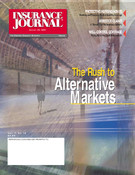I find that nursing homes are in a serious crisis in trying to obtain medical liability coverage,” Texas Insurance Commissioner José Montemayor said in February, as he announced the Texas Department of Insurance (TDI) would for the first time allow not-for-profit nursing homes in Texas access to medical liability insurance through the Texas Medical Liability Insurance Underwriting Association.
Montemayor’s efforts came in response to a deepening crisis in the nursing home industry that involves not only availability of insurance but affordability as well. Rates have skyrocketed in the past two years and, according to various reports, some carriers that were writing nursing home liability in Texas as late as last year, including General Star, AIG and Admiral Insurance, have pulled out of the market.
“The market has hardened dramatically in this class,” said Randall Goss, chairman and CEO of U.S. Risk. “Two years ago there were 21 markets writing this business, now there are three or four, and we’re one of them.”
Goss said there is a “cause and effect” relationship driving the difficulties in the market. “Under-funding is the biggest problem – most homes rely on Medicaid for funding,” Goss said. “Before this session, Texas was in the bottom five percent of the states in the per diem rate for nursing homes. The legislature raised that amount but not enough. And because of under-funding, there’s a consequential problem with understaffing. Homes are unable to keep adequate staff in order to provide proper care.”
Goss pointed out that there has also been generational change in philosophy as to what consumers expect in a nursing home. “We expect the best, the highest level of medical care available,” Goss said, adding that homes haven’t been able to keep up with that demand.
And, Goss said, the very active plaintiffs’ bar looks at the situation and “lawyers see it as being a gold mine for them.” He added that juries have parents too, and if a lawyer can demonstrate to a jury that a problem has occurred, the juries are often swayed. The result is that awards have increased dramatically.
Legislative Action
The Texas Legislature took a crack at nursing home issues during the recent session, passing a couple of long-term care bills: Senate Bill (SB) 1839, the Long-Term Care Facility Improvement Act, and SB 415, which addresses management of and access to Texas Medical Liability Insurance Underwriting Association, commonly known as the joint underwriting association (JUA). The bills address issues such as quality of care, insurance rates and damage awards. They were signed into law by Gov. Rick Perry in June and become effective, for the most part, Sept.1.
Both bills provide access to the JUA for for-profit nursing homes and about 80 percent of Texas’s licensed homes are for-profit facilities. Also, certain provisions of SB 1839 provide tort reform, amending the rules governing the introduction of evidence in a civil trial against nursing homes.
SB 1839 requires licensed nursing homes in Texas to secure coverage for a health care liability claims beginning Sept. 1, 2003. That may affect a change in the market since, according to the Texas Department of Human Services (DHS) – the state agency that licenses nursing homes – there is not now and has never been a requirement that facilities carry liability insurance in order to be licensed.
On its website, the Independent Insurance Agents of Texas (IIAT), speculates that recent legislation may make nursing home insurance more affordable. In addition, the IIAT said legislative efforts may increase available markets and make it easier to find coverage for nursing homes that satisfy minimum underwriting standards.
But others say the legislature still has a lot of work to do before long term problems are solved. “It’s way too early to see if those solutions will come to pass,” said Tim Graves, president of the Texas Health Care Association (THCA), a group that represents for-profit nursing homes. He noted there will be a tremendous impact on the state budget when the requirement that homes carry liability insurance becomes effective, and said the state will have to figure out a way to fund it if they are going to require it.
“The legislature did a couple of things in the recent session, but not enough,” said Ray Thomas, president of Houston’s Bunker Hill Insurance Agency, a general agent for Gulf Insurance Group. “And they won’t meet again for two years.” In addition to funding, Thomas said, the litigation environment needs to be addressed. Trial lawyers are finding a way around state-imposed caps for punitive damages and running up jury verdicts. “If a home has insurance for $1 million and they get hit with a $100 million award,” he said, “there’s a problem.” In Thomas’ opinion, the industry is looking at a five to 10 year stretch before any relief occurs.
Goss put it more bluntly stating that recent legislative action is “meaningless with respect to issues facing nursing homes.” He added that the “legislature is not fixing the problem, they are just dealing with the symptoms.”
JUA
Even though not-for-profit homes currently have access to the JUA program, the underwriting association has none right now, according to Joe Chilton, general manager of the JUA. “The not-for-profits are either finding insurance in the voluntary market or are going bare,” Chilton said.
Graves asserted that more and more nursing homes are going bare. Based on data from DHS, Graves said, one-third of the nursing homes in Texas had dropped liability insurance by February 2001. He noted that percentage represents between 300 and 400 homes.
The JUA was authorized to provide medical liability insurance on a self-supporting basis to physicians and health care providers who cannot find coverage in the voluntary admitted insurance market. All companies admitted to write liability insurance in Texas, currently about 500, must participate in the JUA and pay assessments to cover its deficits when necessary. But SB 1839 also established a policyholders stabilization reserve fund to serve as a back up when fund resources are overwhelmed by claims. All policyholders are charged an annual fee, separate from premiums, in order to fund the reserve.
Chilton said the legislation could affect the JUA’s rate scheme, because of the tort reform written into SB 1839. In addition, the bills require rates for not-for-profit nursing homes to be at least 30 percent lower than for-profit home rates. “And we don’t know how to project what’s going to happen with the for-profits,” Chilton said.
Currently, maximum limits for nursing home liability polices written by the JUA are $1 million per claim and $3 million in the aggregate per year. Minimum limits run about $100,000 per occurrence to $300,000 per year in the aggregate. Premiums run about $858 per occupied bed for a first-year, claims made policy to $5,800 per occupied bed, based on average annual occupancies. The association has no mandatory deductible in place, but one can be negotiated, Chilton said. In addition, punitive damages are not covered by JUA policies.
Skyrocketing Costs, Litigation
According to the THCA, the cost of nursing home liability insurance increased ten-fold between 1996 and 2000, with costs soaring from an average of just under $600 per bed to between $2,000 and $5,000 per bed.
Bunker Hill’s Thomas said the problem with obtaining this type of insurance is not availability, but cost. You can get the insurance but it’s the price that’s prohibitive, Thomas said, adding he sees rates that vary from $1,000 per bed to $5,000 per bed in Texas, depending on the situation. “If the rate is $3,000 per bed and you have 100 beds,” Thomas said, “that’s $300,000 per year and most homes can’t afford that. The source of the problem is litigation.”
“What I understand is that we do have a litigation environment that is pretty explosive,” said Graves. Gregg Peterson, with Illinois-based Insurance Program Managers Group (IPMG), underscored Thomas’ and Graves’ remarks stating, “litigation is the greatest driving factor in the market.”
Graves said jury verdicts have been going up, with verdicts of $200 million to $300 million at the upper end. He acknowledged that those awards are usually settled but noted that settlement amounts are rising too, with settlement amounts of $300,000 to $400,000 not being uncommon.
Rates and Coverage
Rates for nursing home liability insurance are all over the map, Peterson said, adding the biggest thing carriers look at when assessing a nursing home risk are the reports completed by federal and state agencies. They are essentially a report card on how well the nursing home manages its operations, he said, and carriers don’t like it if a facility gets a bad report card – if there were difficulties in the operations or the loss history is problematic. In addition, carriers will examine a nursing home’s overall management, as well as its programs, services and staff training.
In Texas, rates are varied, running from around $500 per bed to more than $5,000 per bed depending on any number of variables. Limits for available policies tend to run in the range of $1 million per occurrence and $3 million in the aggregate. Most policies are written on a claims-made basis, with some exceptions. U.S. Risk writes both claims-made and occurrence based policies.
Uni-Ter, a subsidiary of U.S. Re, handles underwriting and claims for Clarendon America Insurance Company nursing home program (formerly a MEDMARC Mutual program). The company specializes in policies for smaller, independent nursing homes in Texas and other states. Robert Allen, underwriting manager for Atlanta-based Uni-Ter, said the company’s program sets rates according to variables such as location and history. The program divides the state into three tiers, with the Houston-Galveston area having the highest rates, the Dallas area having the next highest, and the rest of the state rated lower. Allen said rates in rural areas can run as low as $500 per bed and that $1,000 per bed would be at the higher end of the company’s Texas rates.
U.S. Risk has its own in-house facility to write nursing home policies and Goss said the company does a substantial amount of business. The company’s rates in Texas run from around $600 per licensed bed to $1,800 per licensed bed, and it offers a credit for unoccupied beds. In addition to a $1million/$3 million per location limit, U.S. Risk also offers a $10 million to $20 million overall policy aggregate limit, regardless of location. The company assesses policies on a case-by-case basis, using variables such as location and risk classification of a home to establish rates.
Deductibles are also a big issue, according to Peterson. He said deductibles of $500 per claim would be on the low end, while on the high end, self-insured retentions could go as high as $500,000 or $1 million.
Goss said the standard deductible for U.S. Risk polices is $50,000 in Texas, but the deductible can go as low as $10,000 if the risk warrants it. Comparatively, Uni-Ter prefers to offer policies with lower deductibles, said Allen, with $5,000 per claim being the average.
According to DHS figures, 1,235 nursing homes and 1,356 assisted living facilities currently hold licenses in Texas. While figures for assisted living facilities remain about the same as last year, the number of nursing homes is down 2.91 percent from last year’s count of 1,274. With occupancy rates hovering around 70 percent and Medicaid providing funding of between $80 and $90 per day per bed, short term solutions to the difficulties in the nursing home industry are not likely to effect significant improvement in the market.
Whether it takes two or 10 years to rebound, the fact remains that currently, the market seems to be on a downward spiral. As Goss put it, under-funding leads to understaffing, which leads to less-than-adequate care, which leaves homes vulnerable to litigation – the insurer’s nightmare.
Topics Trends USA Texas Profit Loss Underwriting
Was this article valuable?
Here are more articles you may enjoy.


 Brown & Brown Files Suit Over Alleged Howden Poaching of 200+ Employees
Brown & Brown Files Suit Over Alleged Howden Poaching of 200+ Employees  UPS Ripped Off Seasonal Workers With Unfair Pay Practices, Lawsuit Alleges
UPS Ripped Off Seasonal Workers With Unfair Pay Practices, Lawsuit Alleges  Louvre Tightens Security After $102M Jewel Heist, Installs Bars on Infamous Window
Louvre Tightens Security After $102M Jewel Heist, Installs Bars on Infamous Window  Wells Fargo Sued by Ex-Manager Who Said Bank Faked Diversity
Wells Fargo Sued by Ex-Manager Who Said Bank Faked Diversity 


